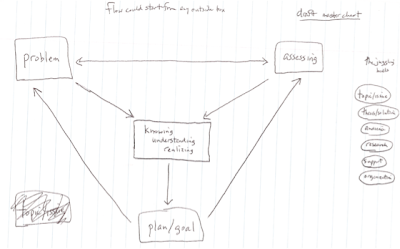I don't know if the hot yoga cooked my brain yesterday or what, but I had trouble thinking this morning as I wrestled some more with my categories. It has come to me that I can group a number of categories together under one umbrella, but I'm struggling with the name for this grouping. I can say with clarity that I have seen this grouping or dynamic from the very beginning of my coding, and in fact slice #2 focused almost exclusively on this cluster. I showed it to my wife, and she said it reminded her of what they call algorithms in her pediatric references--there are certain elements and the flow between them varies. Here is the graphic of this algorithm for writer's reviews again:
I saw that I could chunk writing reviews into sets of these algorithms. A single WR would move from topic to topic and variously go through this sequence. For the most part they cycle toward the end point of "coming to know" and formulating a "revision goal." I think I will be redoing this diagram, but these categories that work together within this algorithm are:
--problem thinking
--feedback thinking
--assessing/reassessing
--coming to know
--revision/fixing thinking
What to call this cluster? I think this legitimately counts as a category because they all share these common elements, but at this point I can think of nothing more clever that "review topics." Categories are supposed to be conceptual in nature. That is not conceptual. What are they doing? What is happening? They are addressing writing issues and figuring out what to do about them. The one benefit of "review topics"is that it aligns with the prompt-determinism within all these Writing Reviews. Despite this prompt determinism, I can still see this dynamic at work. Maybe "addressing a writing issue." But sometimes the WRs ask to address topics that related to feedback or research. I'm still wrestling with this terminology.
I am also wresting with how to handle the "telling/reporting what is" vs. "considering/evaluating what is" dichotomy. This dynamic is important because I believe it marks the divide between awareness and reflection, between representing reflective thinking and engaging in it. It occurred to me in the shower (no kidding) that perhaps these two qualities operate on the dimensional level. I can have problem thinking on audience which could be reported thinking or it could be presently considered. The category or subject does not change, but it could be considered in either of these two ways. Hmm. I will have to see how this way of representing the data will work. I also have struggled about where to place the very important concepts of "fitting in bounds" and "essay/writing success." Are essay success and writing success sub-categories of "fitting in bounds." OR is the concept of essay success again something that operates on the dimensional level. Whenever a writing issue is considered or problem identified or plan conceived, EVERYTHING is gauged against the concept of essay success. It is the ultimate goal and arbiter of everything.
I'm just not sure how or where to fit "essay success" into the dynamic. I'm halfway tempted to make it the core category, but I'm this cluster I have talked about here might be the core category.
I'm struggling here because I feel that I am leaping out of open coding into axial coding and it hurts my brain.
I don't really like these terms as yet.
Subscribe to:
Post Comments (Atom)
About Writing
Writing is always more precise and less precise than our thoughts: that is why our writing pieces glow with being and beckon with the promis...
-
As Ian Dey notes, the conceptual elements of categories, properties, and dimensions can be a muddle and the distinction between them can get...
-
I just picked up Stephen North's The Making of Knowledge in Composition: Portrait of an Emerging Field (1987) and I found a passage tha...
-
Article summary Boud , David, Rosemary Keogh, and David Walker. "Promoting Reflection in Learning: a Model." Reflection: Turning E...

No comments:
Post a Comment